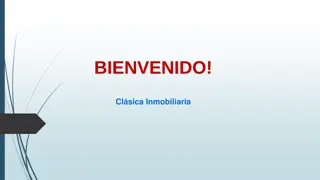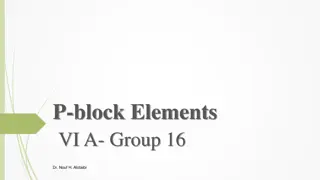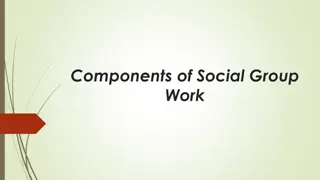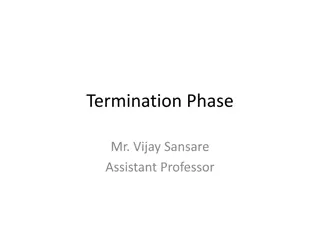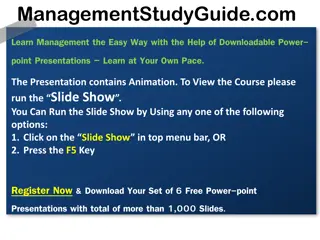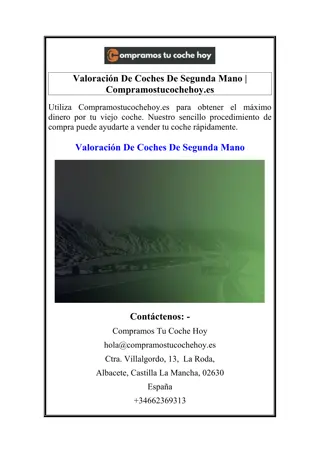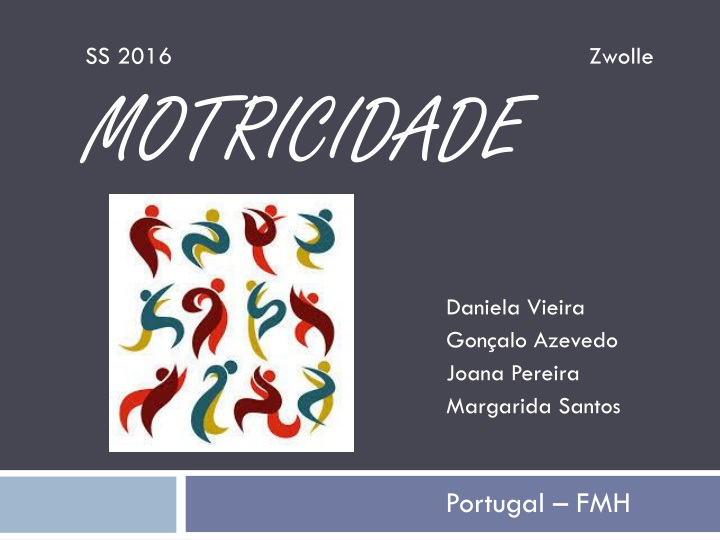
The Human Psychomotor System and Stress Management through Dance Movement Therapy
Explore the theory of the human psychomotor system, Luria's theory, the seven psychomotor factors, consequences of poor psychomotor development, and ways to manage stress through dance movement therapy. Enhance your understanding of psychomotricity and discover strategies for improving mental and physical well-being.
Download Presentation

Please find below an Image/Link to download the presentation.
The content on the website is provided AS IS for your information and personal use only. It may not be sold, licensed, or shared on other websites without obtaining consent from the author. If you encounter any issues during the download, it is possible that the publisher has removed the file from their server.
You are allowed to download the files provided on this website for personal or commercial use, subject to the condition that they are used lawfully. All files are the property of their respective owners.
The content on the website is provided AS IS for your information and personal use only. It may not be sold, licensed, or shared on other websites without obtaining consent from the author.
E N D
Presentation Transcript
SS 2016 Zwolle MOTRICIDADE Daniela Vieira Gon alo Azevedo Joana Pereira Margarida Santos Portugal FMH
Introduction The theory of the human psychomotor system (SPMH). Luria s Theory and SPMH. The seven psychomotor factors. What are the consequences of a poor psychomotor development? How to manage stress? Dance movement therapy. Activities. Conclusion.
The theory of the human psychomotor system (SPMH) Motricidade is common in every vertebrate animals. Due to the environment and the connection with the human species, the neuroanatomy of the brain (lobes) became more specific and complex. Therefore Psychomotricity appear as something exclusive and special in the human being. (Fonseca, 1994)
Lurias theory of brain functioning and SPMH According to Luria (1975), the brain is divided in three parts: 1st attention, vigilance, sensorial integration; 2nd analysis, synthesis, information storage and senses association; 3rd planning, programing and regulation of the motor act. (Fonseca, 1994)
The seven psychomotor factors Fine praxis Global praxis Space and time structure Body awareness Lateralization Balance Tonicity (Fonseca, 1994)
What are the consequences of a poor psychomotor development? According to Fonseca (1994), a poor psychomotor development can lead to learning and motor difficulties (e.g. problems in graphomotricity). Low performance Children with motor difficulties Criticized by the peers Increased stress and anxiety (Schoemaker & Kalverboer, 1994)
How to manage stress? Dance Movement Therapy Emotional, cognitive, physical and social integration of the individual Creative body-oriented psychotherapy (movement, dance, verbal interaction) Brauninger (2012)
Dance movement therapy Stress management improvement Stress reduction Interpersonal sensivity Distress reduction Awareness (senses, feelings, images, thougths, cognition) Relaxation Brauninger (2012)
Activities Activity A: Level 1 standing in a circle, each person has to pass a ball (for instance, red) to the person in the right. When the therapist claps once, the way the ball goes has to change. Level 2 adding a second ball (for instance, green) they have to do the same by passing each ball in tthe oposite way. Level 3 (continuation) and when the therapist claps twice, all the participants have to march at the same place (note: the activities will variate according to the group characteristics)
Activities Activity B: Listening to a music chosen by the therapist, each person starts to move their body parts, according to the orientation of the therapist (for instance, arms first, then the head...) The participants have to try to be in the flow of their feelings and be aware of their body sensations.
Conclusion Psychomotor factors can be a point of reflection in all the workshops we have done; Psychomotor development influences the body awareness and all that is experienced throughout our lives; The way you experience your body will make you understand yourself, others and the environment.
References Brauninger, I. (2012). Dance movement therapy group intervention in stress treatment: A randomized controlled trial. In: The Arts in Psychotherapy, n 39, pp. 443-450. Fonseca, V. (1994). Psicomotricidade e Psiconeurologia: Introdu o ao Sistema Psicomotor Humano. In Revista Neuropsiquiatria da Inf ncia e da Adolesc ncia vol. 2, n 3, pp. 23-33. Schoemaker, M., Kalverboer, A. (1994). Social and Affective Problems of Children Who Are Clumsy: How Early Do They Begin? In: Adapted Physical Activity Quarterly, vol 11 (2), pp. 130-140











